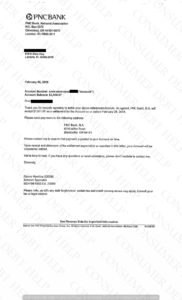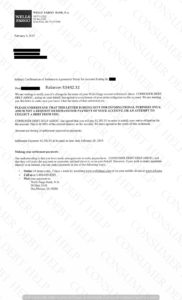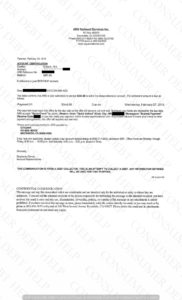Debt Relief Specialist wants to share a settlement letter from Avant/Web Bank. Bal. $8133.25 Offer $3254.00 Savings $4879.25

Debt Relief Specialist wants to share a settlement letter from Avant/Web Bank. Bal. $8133.25 Offer $3254.00 Savings $4879.25

Debt Relief Specialist wants to share a settlement letter from PNC Bank. Bal. $3366.87 Offer $1011.00 Savings $2355.87

Debt Relief Specialist wants to share a settlement letter from Wells Fargo. Bal. $3482.32 Offer $1392.93 Savings $2089.39

Debt Relief Specialist wants to share a settlement letter from Best Buy/Citibank. Bal. $981.85 Offer $344.00 Savings $637.85

Tax Time Is Here Again – How to Claim the Insolvency Exemption for Canceled Debt Reported on Form 1099-C
If you are a new client and 2018 was the first year we obtained a settlement for you then this is new to you and we want to give you some information. See the article below, since Consumer Debt Help Association is not an accounting firm, we can not advise you on how to file any tax forms. We can only give you information that is posted from the web for you to review and to better educate yourself. We found the following article that has a lot of good information. We also have a corporate accountant that you can speak with if you have additional questions.
It’s that time of year again. Millions of people who settled or had debts forgiven last year are receiving Form 1099-Cs for Cancellation of Debt Income and wondering if they will have to pay taxes on the forgiven amounts.
Many people are shocked to learn they might owe taxes on canceled debt balances. But it’s true. According to the IRS, forgiven debt translates to “income” because you enjoyed the goods and services that were originally purchased on credit but did not fully pay for those benefits. When a lender has to record a partial loss on those purchases, the IRS wants you to treat that formal loss as ordinary income.
Fortunately, a legitimate loophole is provided by the IRS in the form of the insolvency exclusion, IRS Form 982. “Insolvent” means the same thing as negative net worth, where you owe more in liabilities than the total fair market value of your assets. If you are insolvent at the time you reach a settlement with a creditor, then you can offset the 1099-C income up to the amount by which you were insolvent.
For example, let’s say you owned assets worth $50,000 at the time you had a $20,000 debt canceled. At the time, you also owed $80,000 in total debt, including the $20,000 that was forgiven. This means that your net worth was a negative $30,000. At the time the debt was canceled, you were therefore insolvent by $30,000 and would not have to pay taxes on any portion of the $20,000 debt that was canceled and reported via Form 1099-C.
In order to determine whether or not you qualify for this 1099-C exemption, you need a copy of IRS Publication 4681, which contains a worksheet for calculating insolvency. Publication 4681 provides detailed instructions for completing Form 982 — affectionately called “The Tax Form from Hell” due to its byzantine complexity. Form 982 is the document you include with your Federal Form 1040 to claim the insolvency exemption.
Determining insolvency is pretty straightforward if you only have one 1099-C for the given tax year. However, if you settled multiple debts in the same year and have a bunch of 1099-C forms, that is when it can get tricky. Unfortunately, the IRS instructions say nothing about the correct method for determining insolvency across multiple settlements. Further, taxpayers’ eyes tend to glaze over when they reach Part II of Form 982 and try to figure out what the IRS means by “reduction of tax attributes.”
Here are a couple of tips to help you understand two key areas that often confuse taxpayers. First, it’s common for people to stumble when they see the line on the insolvency worksheet that asks you to list your “interest in a pension.” To most of us, “interest” means the annual rate of return we might earn on invested money. But that’s not what “interest” means in this context. It means your ownership stake in the pension or retirement account in question.
For example, let’s say you have an IRA account through your employer where they are matching your contributions, but you are not 100% vested in their matched funds until you’ve worked for the employer for a certain number of years. If your IRA balance is $20,000, but you’re only 50% vested, then that asset would be listed at $10,000 on the worksheet.
Another area that is confusing is how to calculate insolvency when the 1099-C is issued in one spouse’s name only, yet taxes are filed jointly. Must you include the entire household’s assets and liabilities in the calculation? The answer is no. The IRS allows you to split the calculation so that only the spouse named on the 1099-C has to demonstrate insolvency, based on the assets and debts held solely in that spouse’s name, and a pro-rated basis for assets and debts held jointly.
These points and many others are discussed in the extensive User Manual that comes with the Excel based spreadsheet calculator. Multiple examples are included to illustrate different scenarios not directly discussed in the official instructions. ZipDebt’s IRS Form 982 Insolvency Calculator will save you time and money if you’re dealing with 1099-Cs from settled debts!
Click Link below to get directly to the Publication 4681 – Introductory Material
IRS.gov
If your credit report is less than squeaky clean, don’t despair. Regardless of how creditors may make you feel, it is not a judgment on you as a person, but simply a report on how you’ve handled your credit related financial obligations. You will need to take a few active steps to set the record straight for the future.
Once you are done with your Debt Settlement Program there are some steps that you need to take to improve your credit. It will take a little time but it will happen before you know it if you stick to the plan.
After all of your debt has been settled, you need to ensure that you pay your bills on time moving forward. Many creditors will consider lending to someone with some late payments, if recent records show that you’ve mended your ways. However, in some extreme circumstances like bankruptcy or tax liens, nothing has a greater negative impact on credit. The due date for a payment is when it has to be in the hands of the creditor, not postmarked. Anything more than 30 days late will hurt your credit standing and set you back again, often seriously. Keep in mind that one day past the due date is considered 30 days late.
When it comes to the number of credit cards you should have, fewer is generally better. Having a few clean, active charge accounts will boost your score. Remember to keep your balances lower than 35% of your credit limit, meaning if you have a $1000.00 limit on your credit card never have a balance higher than $350.00. Even if you pay the credit card off every month it will still be reporting to the credit bureaus as the high balance on the account.
Minimize your outstanding debt. Even if your debt is relatively small and your monthly payments are manageable, having outstanding debt is always a negative factor. Try to pay down your existing debt as quickly as possible within your budget limitations.
Time is sometimes your best ally. Although you will have late payments or other derogatory information on your credit report, the more time you can put between such negative information and a better record of on-time payments and low debt, the more favorable your credit profile will appear in the eyes of lenders. Although negative information can stay on your credit report between 7 and 10 years, every month that passes where you exhibit responsible credit behavior is a positive step.
copyright 2024 Consumer Debt Help Association - 516 N. Dixie Highway, Lantana, FL 33462. All Rights Reserved